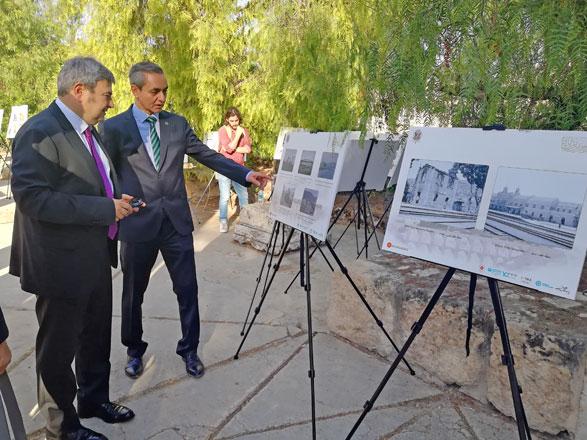You are here
Exhibition traces cultural heritage of Hijaz Railway
By Bahaa Al Deen Al Nawas - Jun 25,2019 - Last updated at Jun 25,2019

Turkish Ambassador to Jordan Murat Karagöz (left) tours an exhibition on the Hijaz Railway in Amman on Monday (Photo by Bahaa Al Deen Al Nawas)
AMMAN — Turkish Ambassador to Jordan Murat Karagöz on Monday opened an exhibition focusing on the Hijaz Railway at Darat Al Funun in Amman.
The Hijaz Railway, an old train route built by Sultan Abdülhamid II of the Ottoman Empire, connected Damascus to the Hijaz, Karagöz told The Jordan Times during the event, noting that the railway took a long time to complete because of dire financial conditions at the time.
“This exhibition aims at showing people how not only Muslim countries, but also non-Muslim countries contributed to finalising the construction of the railway,” he said, adding that it also aims at showcasing photos of the railway selectively chosen from the Turkish archives.
The images were selected by the director of the Yunus Emre cultural centre with support from the Turkish Cooperation and Coordination Agency (TIKA), and depict what was accomplished nearly 100 years ago, the ambassador said, thanking the Jordanian government “for preserving the heritage, which is a common heritage of the entire Middle Eastern peoples”.
The opening of the “Railways from Istanbul to Hijaz: Archive Documents Exhibition & Conference” was attended by TRH Prince Asem Bin Nayef and Prince Ali Bin Nayef, in addition to officials and ambassadors from Jordan, Turkey and several other countries.
The Turkish ambassador delivered an opening speech providing historical background on the railway, including the obstacles it faced during construction.
Following the opening speech, Professor Azmi Özcan said “the project was a major one, beyond the capacity of the Ottoman Empire, and yet it was done with a budget of 4 million Turkish lira, which was more than $10 million”.
Donations from many countries helped finance the project, the professor noted, adding that even students donated parts of their scholarships to the endeavour.
The railway extended over 1,500 kilometres, according to Özcan, who stressed the cultural significance of the project.
For his part, TIKA Country Programme Coordinator Kürsad Mahmat told The Jordan Times that the agency has been working on the restoration of several old buildings in the Marka area for two years, and it plans on constructing a new museum there by the beginning of 2020.
The exhibition is scheduled to continue until June 30, and was implemented with cooperation between the Yunus Emre institute and TIKA.
Related Articles
AMMAN — Minister of Transport Jamil Mujahed on Wednesday visited The Jordan Hijaz Railway Corporation (JHRC) where he met with JHRC Director
AMMAN — Turkish Ambassador to Jordan Murat Karagöz on Thursday met with Culture Minister Nabih Shuqum, a statement from the Turkish embassy
AMMAN — While southern Jordan witnesses an abundance of ancient sites, a British archaeologist decided to study the 20th century archaeology












